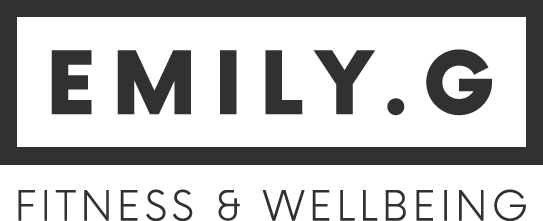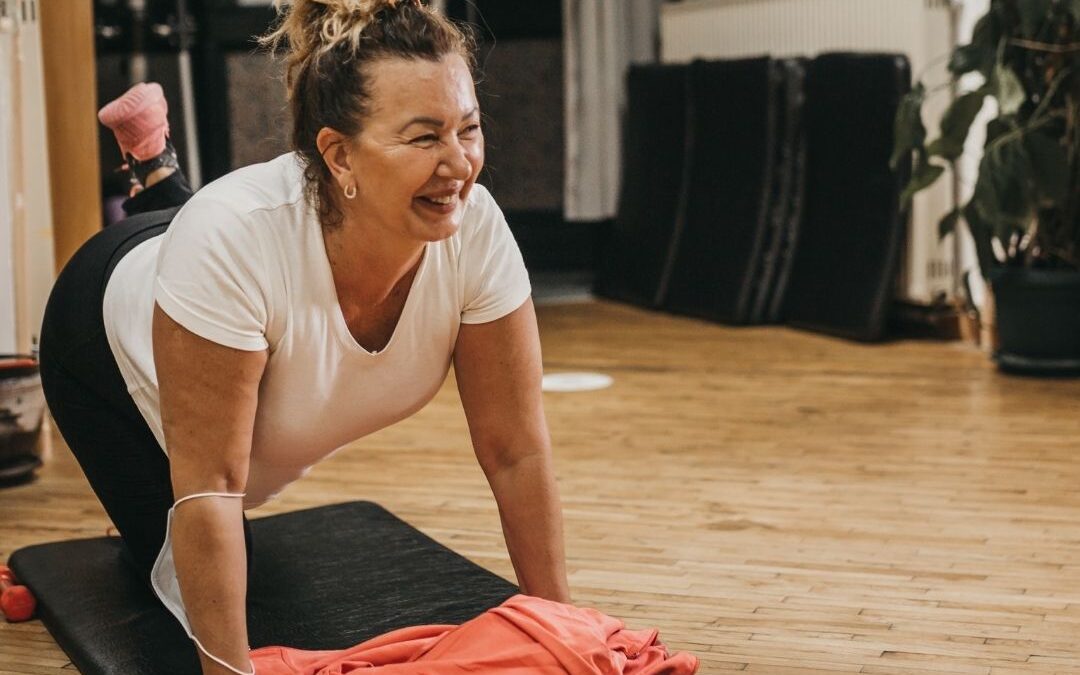Menopause exercise
The perimenopause and menopause journey will be different for every woman. Some will sail through relatively unscathed and others may suffer with symptoms for many years. However, many will experience some of the many menopause symptoms to a greater or lesser degree. Including weight gain, hot flushes and mood swings. Sadly there is no one ‘magic bullet’ for dealing with these symptoms. As with many things in life the best approach is holistic. Taking in all aspects of health and wellbeing to help to manage uncomfortable symptoms. Making tweaks to nutrition, mental health – via stress reduction and better sleep – and exercise can all work to control and ease the symptoms of menopause and perimenopause.

Weight gain in menopause
During menopause many women find that they gain weight particularly in the tummy area. Often in spite of eating well and exercising as normal. On average women gain around 10 pounds during the course of menopause.
As oestrogen levels in menopause begin to fluctuate and decrease the body begins to hold onto body fat. The ovaries are no longer producing a reliable source of oestrogen. So the body begins to look elsewhere for the oestrogen it needs to support its metabolic functions. Body fat is a source of oestrogen and so naturally the body begins to hold onto higher levels of fat to provide a backup source of the oestrogen it still needs.
The dreaded ‘middle age spread’
As many women find to their dismay, the fat distribution of the body also changes. Storage moves away from the hips and thighs and onto the abdomen, Creating the ‘middle aged spread’ that is all too familiar.
The diets that worked perfectly in the pre-menopause years are no longer be effective. Radical diets, juice cleanses and hours on the treadmill just don’t cut it in your 40’s and 50’s like they used to.
It does seems that the odds are stacked against women during this time. But don’t despair! Weight gain does not need to be inevitable or permanent. Choosing the right menopause exercise, along with careful nutrition planning, can help to reduce weight gain or prevent it before it happens.
Osteoporosis prevention
Our bones are constantly remodelling – building up and breaking down bone cells. Until our mid-30s the process of bone building is greater than the breakdown and bone density is increased.
However, at around 35 in women, the process is reversed. The breakdown and reabsorption of bone cells begins to outstrip the new bone being produced. Oestrogen plays a large role in the bone remodelling process. Protecting bone density in earlier life. As oestrogen levels drop with the menopause, this protective role is lost and bone mass is lost at a higher rate. Without any action being taken, this loss of bone density can lead to increasingly fragile bones and the onset of osteoporosis (porous bone).
Menopause exercise can play a major role in preventing osteoporosis. The pressure on the bones and muscles which happens with weight bearing and resistance exercise causes a reaction in the bones. The body begins to increase muscle strength and produce more of the bone building cells which strengthen the bones. This helps to offset the effects of menopause related oestrogen loss on bone mass. Alongside diet and lifestyle changes, regular resistance training can help to prevent osteoporosis from developing.
Boost your mental health with menopause exercise
Oestrogen is a key player in the formation of serotonin – the body’s natural mood stabiliser. During menopause as oestrogen drops so do levels of serotonin. This can lead to the mood swings, irritability and anxiety that many women experience during perimenopause.
You probably already know that exercise has a hugely beneficial effect on mental health and wellbeing. The chemicals released during exercise help to regulate mood and reduce stress and anxiety. This becomes even more vital during perimenopause when many women feel ‘out of control’ of their bodies and moods. Menopause exercise also promotes better sleep patterns and improves brain chemistry. Helping to combat the mood alterations that can occur during perimenopause as oestrogen levels drop.
Exercise smarter not harder
Stress is a huge factor in the symptoms many women experience during menopause with elevated cortisol linked to weight gain. Women in the perimenopause and menopause need to exercise in ways that will decrease stress. It is very possible to boost the metabolism, increase lean muscle mass and bone density without adding too much to the cortisol levels. It may be a cliche but this really is a case of work smarter, not harder.
Menopause exercise will help to improve cardiovascular health, reduce body fat and improve lean body mass. In order to do this women should be regularly exercising but also taking into account the changes in the body. Decreased levels of hormones such as oestrogen and progesterone, increased levels of cortisol (the stress hormone) and insulin (the fat storing hormone.
Strength training
Resistance training should be a priority for perimenopausal and menopausal women. Resistance training will increase lean muscle mass – muscle is a metabolically active tissue so the more lean muscle mass you have, the higher your metabolism and more efficient the body is at fat burning. You should aim to resistance train 2-3 times per week.
HIIT
High intensity interval training. HIIT is an efficient method of training incorporating a short interval of high intensity work with rest periods (e.g. 30 seconds of work/30 seconds of rest) which will increase cardiovascular health and your metabolism while protecting, and possibly increasing, muscle mass. Long duration cardio of an hour or more can raise cortisol levels and increase the body’s stress response, leading to greater levels of abdominal fat, which is the opposite to what we want during the menopause. Keeping your workouts short and intense will help combat this effect. Aim to do HIIT at least twice a week.
Rest and recovery
The body adapts at rest, this is when it will build muscle and recover from the workouts. Active recovery and mobility work such as yoga or long walks are an ideal way to help the body recover and de-stress.

